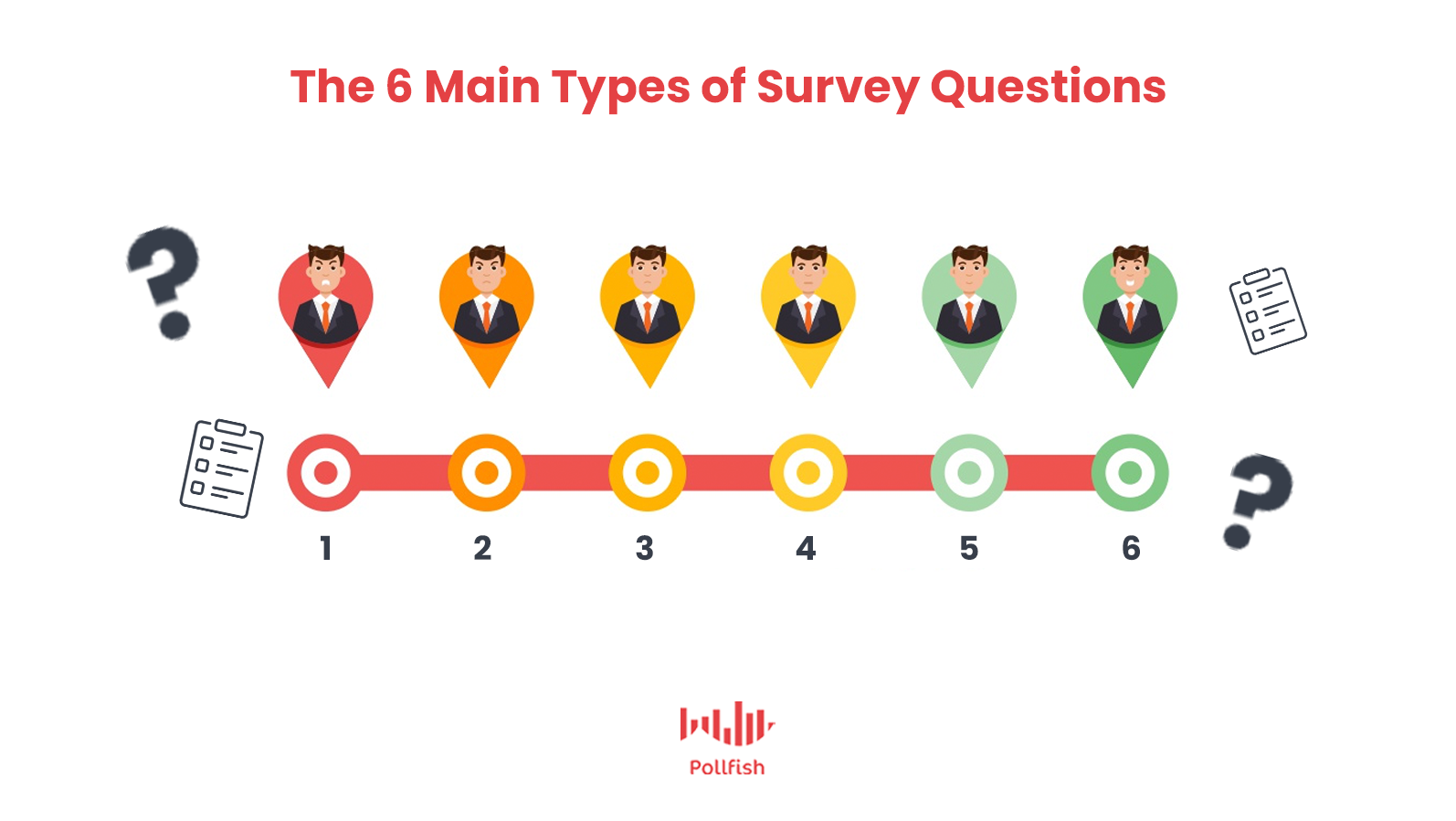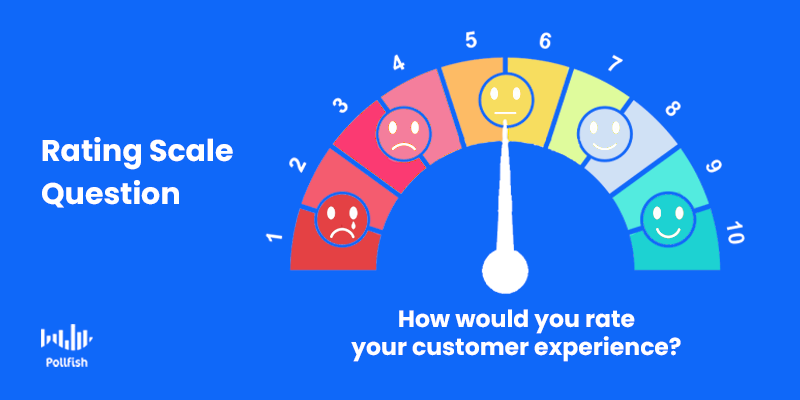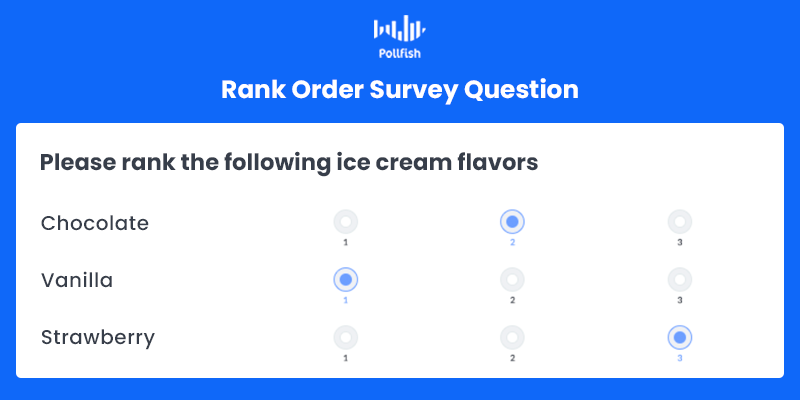The 6 Main Types of Survey Questions to Power Multiple Applications
 Survey questions are the core of any questionnaire and survey at large. It is the questions that drive the extraction of key data, insights and other information about your target market (for market research) or target population (for general research).
Survey questions are the core of any questionnaire and survey at large. It is the questions that drive the extraction of key data, insights and other information about your target market (for market research) or target population (for general research).
There are a wide variety of survey questions to implement into your survey campaign, whether it is for market research or other forms of research. There are also many ways to categorize questions.
This article expounds on the 7 main types of survey questions, namely market research questions, including examples and fitting applications, so that you can produce effective survey studies for your research campaign.
Close-Ended Questions
These questions are one of the most chief types of survey questions. They serve as the parent category in virtually every question type you’ll come upon in this guide and all others — except for open-ended questions, their antithesis.
Close-ended questions refer to any question that can be answered by selecting from a limited amount of answer options. These options can exist in various forms; these forms are the basis of the various offshoots, subtypes or child categories of close-ended questions (listed in the sections following the next).
Usually, these exist as multiple-choice questions, in which a respondent can select one answer, or choose several, i.e., all that apply to a situation.
Close-ended questions can draw simple, one-word answers, such as yes or no, or full sentence answers.
Additionally, these questions can be presented in a rating scale, such as “Are you satisfied with your experience with our company?” To which, the responses would exist in a scale: Very much so, mostly, yes, not sure, not really, no, not at all.
Close-ended questions are used to conduct quantitative research, in which data is collected to form statistics and discover patterns.
Although they give limited information, they are useful for several applications in the business world and virtually all others. They should be used when searching for trends and quantifiable behaviors and making generalizations.
Additionally, they provide quick insights into both general and specific topics, including important issues, such as that of trust:
“Do you find our website trustworthy to gather [niche] information?” This can be answered via a simple yes, no or not sure or as a rating scale question, e.g., from “not at all” to “very much so.”
Here are some of the most fitting surveys and applications for close-ended questions:
- Quantitative surveys
- Consumer surveys
- Cross-sectional surveys
- The NPS Survey and all other customer satisfaction surveys such as the CSAT and CES surveys
- Brand awareness surveys
- All customer experience (CX) surveys
- Business surveys
Examples of Close-Ended Questions:
- Did you find what you were looking for on our website?
- Which products do you look for/enjoy using the most? (Check all that apply).
- What times of the year do you usually plan a trip? [Multiple choice, multiple selection]
- Would you recommend our product/service?
- Which locations would you go to?
- What aspects of your life do you find most stressful?
- What kinds of services do you seek to help you through a difficult time?
Open-Ended Questions
The opposite of close-ended questions, these types of questions cannot be answered via a simple yes or no answer, nor can they be answered with single or multiple-selection multiple choice answers.
Rather, they allow the respondents full control over their responses. As such, open-ended answers can be short, consisting of a few words, to a sentence, to a paraph and beyond.
As their name suggests, the responses for these kinds of questions are limitless, save for the character count. These questions are used to extract in-depth responses to better probe into a topic. Additionally, open-ended questions can be used as follow-up questions to close-ended answers.
For example, if you asked the close-ended question: Which of the following brands do you feel is this best for your needs?
You can follow this up with an open-ended question that asks respondents to explain why they chose their answer.
Open-ended questions provide feedback in the customers’ own words, rather than with fill-in options that have been preselected. Open-ended questions form the core of qualitative research.
They help you draw more context around actions, opinions and explore the reasoning behind satisfaction and dissatisfaction with their customer experience (CX).
Here are some of the most fitting surveys and applications for open-ended questions:
- Qualitative surveys
- Retrospective surveys: they require these questions to express and compare feelings and opinions of the present with the past.
- Exploratory research: qualitative in nature, used in order to form hypotheses, define goals etc.
- Consumer surveys
- Employee feedback surveys, job satisfaction surveys
- Event evaluation surveys
- Prospective research
Examples of Open-Ended Questions:
- What was it like living in this neighborhood in New York?
- Please describe a time where you found our digital marketplace helped you make essential purchases.
- Why did you select [the previous question’s choice]?
- How do you typically deal with stressful situations?
- What would make you use our product/service again?
- Why do you choose this particular product over the others?
- Is there anything else we can do to improve your experience with our company?
Rating Scale Questions

Also referred to as ordinal questions, these questions use a scale of answer options, as opposed to answers with words and sentences that denote separate objects and concerns.
As its name suggests, a rating scale question asks respondents to rate a sentence from a scale that uses numbers, emoticons, emojis or words. The words of the scale usually denote levels of either low to high intensity or go from negativity to positivity.
Respondents choose the number, word or emoji that best represents their answer.
Rating scale questions can be used for a number of applications. They are essential for questions that require far more nuance and precision than a yes or no answer. They are also ideal for a market researcher to understand their customers’ exact feelings, attitudes and beliefs towards a number of business inquiries.
WIth rating scale questions, market researchers can further segment their target market by way of their opinions, which allows them to tinker their products, services or experiences more precisely.
Here are some of the most fitting surveys and applications for rating scale questions:
- NPS (Net Promoter Score) surveys
- CSAT (Customer Satisfaction Score) surveys
- CET (Customer Effort Score) surveys
- Likert Scale surveys
- Visual ratings surveys (ones that use hearts, stars, emojis or other visual ratings as scaled questions).
Examples of Rating Scale Questions:
- How likely are you to recommend this company to a colleague or friend, on a scale of 1-10? (NPS)
- Rate the following statement. Using the site navigation was extremely easy to do. (CES, a scale of extremely disagree to extremely agree).
- Overall, how satisfied are you with our company? (CSAT, a scale of extremely dissatisfied to extremely satisfied).
- The number of items in your online store overwhelms me. (Likert Scale, a scale of 7 options, strongly disagree to strongly agree).
- How would you rate your experience with our tech specialist? (Visual ratings scale, answers can use any emoji)
Matrix Questions
A Matrix question is a kind of close-ended question that asks respondents to provide an answer to one or more row questions using the same set of column answer choices. In this way, researchers do not have to create different answer types for each Matrix question, as each one can be answered in the same way.
It is similar to rating scale questions in that these questions ask respondents to rate or evaluate a number of services, occurrences of matters.
Like rating scale questions, each answer in a Matrix question carries a different amount of weight or intensity, from strong disagreements to strong agreements and other negative to positive responses.
The design of Matrix questions appears to be a chart, which makes it easy to identify and create.
Matrix questions are fundamental to use when your questions require nuance or you want to understand your customers’ precise sentiment in regard to your question.
While they can make it easy to interpret your customers’ answers, be wary when using them on mobile. Very long Matrices don’t fit mobile screens, which tend to be far greater in length than in width. They are not recommended for mobile.
Here are some of the most fitting surveys and applications for Matrix questions:
- Employee satisfaction surveys
- Descriptive research
- Customer loyalty surveys
- Evaluating advertisements and advertising campaigns
- Product satisfaction surveys
Examples of Matrix Questions:
- Rate the following: The customer support rep helped me resolve my issue. (Matrix from strongly agree to strongly disagree)
- How was your experience at our trade show? (Matrix from highly unenjoyable to highly enjoyable).
- How would you assess our webinar? (Matrix from very uninformative to very informative)
- How likely are you to make ongoing purchases from our online store? (Matrix from highly unlikely to highly likely).
- How many times will you make purchases from us in a year (Matrix from once to several times, such as more than five times).
Rank Order Questions

Also called Ranking questions, rank order questions ask respondents to compare items and rank them according to their liking. As such, respondents order the answer options by way of their preference.
It allows them to rearrange multiple choice answer options in the order of their choice, based on the opinions and attitudes they hold. Using rank order questions as opposed to other multiple-choice questions or rating scale questions is beneficial, as it lets researchers instantly understand their customers’ preference of one item over another.
That is because the rankings are in each question, and unlike the Matrix scale, in which questions/ statements are on each row and answers are in each column, rank order questions feature the studied topics in each row and their ranking in each column. As such, a single question is set up in a Matrix-esque manner. As such, you the items and their ratings one after the other in one box.
This is also more convenient than other multiple-choice questions, in which respondents select multiple items without rating them or rating them but on an individual question basis.
Here are some of the most fitting surveys and applications for Rank Order questions:
- Product surveys
- All customer experience (CX) surveys
- Causal research and correlational research (in part but not in whole)
- Lowering the customer churn rate by understanding which products/ items need improvement
Examples of Rank Order Questions:
- Please rank the following pizza toppings. (Ranking depends on the number of items, ex if there are 4, rate them from 1-4).
- How would you rank the following seasonal fashion collections from worst to best?
- How was your experience with the following companies at the event? (Rate from I didn’t enjoy it to I highly enjoyed it).
- Rank the following accessories from our latest collection. (Ranking depends on the number of items).
Nominal Questions
Also called naming questions, or the categorical variable scale, nominal questions label variables into distinct categories. Unlike the various rating questions and rank order questions, nominal questions ask for answers with no quantitative value or weight of positivity, intensity, etc.
As such, these questions require no calculations of their answers, as each answer names a different category or type that has no quantitative relation to the other answer options. When numbers are assigned to nominal question answers, it is only for labeling or division.
The answers to nominal questions have no order; instead, they are meant to carry significance for variable labels only.
These kinds of questions are apt for initial research, such as exploratory, when researchers are trying to gather all the different variables present in their issue or situation.
They are also perfect to use when inquiring into the specifics of something, whether it is an occurrence, a preference or specific products, rather than rate them against one another.
Here are some of the most fitting surveys and applications for Nominal questions:
- Exploratory research
- Descriptive research
- Product satisfaction survey questions
- Cohort studies
- Advertising market research
Examples of Nominal Questions:
- Which brand of laptops from our store do you prefer? (Answers: Apple, Microsoft, Dell, Acer, Samsung, Asos)
- Where do you live?
- Which vacation destination do you want to visit the most?
- Which of the following ads have you seen?
- Which of the following ads would make you want to buy from us the most?
Making Every Question Count
While the 6 questions described in this guide are crucial for your market research endeavors, there are far more question types you can use to power your survey research. While this may sound daunting, the larger variety of question types helps keep your research quality high and fresh, giving you more types of data analysis to choose from and interpret.
Some questions you may come upon fall under one or more of the question types in this article, while others may be more unique. The most important thing to keep in mind is to not overwhelm your respondents with surveys and survey questions.
Keep your questionnaires relatively short and send your surveys to a random sampling pool. This will ensure that your respondents are not the same exact people every time — yet they still make up your target market/population. You can achieve this effortlessly with a strong online survey platform.
Pollfish Marketing Team
Ready to Try Pollfish?
Create your survey with AI, target high-quality respondents starting at $0.95 per complete, and start getting results in just minutes in real-time. From running a simple product concept survey to managing a constant stream of trackers for dozens of clients in dozens of countries, we’ve got you.
